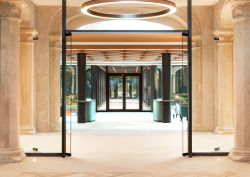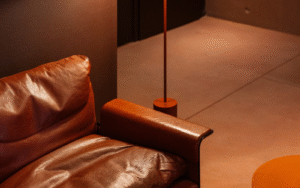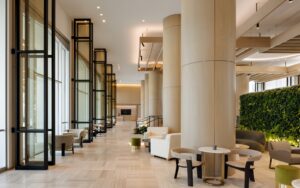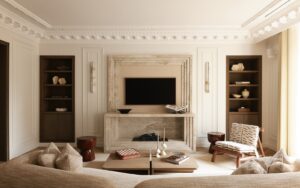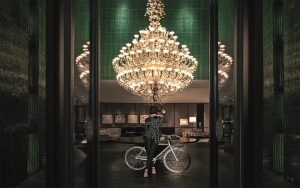Taking the conversation around sustainability and conscious development to the top, Editor Hamish Kilburn, in association with HDR, delivers a roundtable discussion inside The Beaumont Hotel London, to honestly air the challenges and opportunities when it comes to design and architecture’s role in hotel development…

It’s sad that overused ‘buzzword’ terms such as ‘sustainability’ and ‘ethical design’ have become diluted in an industry that has had to battle against a greenwashing culture. For years, I have spoken to designers, architects and suppliers about their passion to design the right way, but have suffered from innovative concepts being thrown out due to them not being deemed feasible.
In 2022, though, the ability to design and develop more meaningfully has become easier, thanks to a collaborative approach adopted by the industry – or forced due to social pressures – as many start to understand the path towards a circular economy. With these real conversations filtering into all elements of hotel design and development, Hotel Designs, in association with HDR, decided to bring together a handful of interior designers, architects and a developer about to start work on a new project, to explore intuitive and conscious hotel development to understand what’s next.
On the panel:
- Matthew Voaden, HDR
- Paul Scriven, HDR
- Jonny Sin, ReardonSmith Architects
- Mark Bruce, EPR Architects
- Veronica Givone, IA Interior Architects
- David Mason, Scott Brownrigg
- Donovan Burn, Dolphin Square Development
Hamish Kilburn: Are conversations you’re having between designers, architects and clients more open in 2022 than they have been in previous years regarding challenges and constraints during the design process?
Mark Bruce: Absolutely, it’s very open from our experience – and that’s probably the most enjoyable element of working in the hotel design sector is the boundless collaborations, whether that be with the interior designer, the building owner, the operator, the developer and main contractor. No one person can have a great idea, and I think that most of the projects we are working on are examples of that statement, where there have been great minds at the table, with different skills and specialties, from day one.
Over the last few years, some of the projects that are arriving on the market are exceptional, and with more complexities, such as cost and sustainability incentives, that collaborative approach is required. Sometimes, there are up to 30 consultants on a project, which can only result in a positive evolution in hotel design moving forward.
Matthew Voaden: I think the difficulty we always had, working on MEP, is that we were always brought into the project too late to make any changes to the foundations. Now, though, we are having conversations at concept stages, meaning that we can ensure the solutions we put forward are achieved, especially when implementing a cradle-to-cradle philosophy.
Donovan Burn: Even in our office, we ensure that the whole team who are working on these developments – from design to operation and everything in between – sit together in order to encourage a consistent level of communication in order to discuss, early on, the challenges and to come up with solutions together.
HK: Are your clients more aware and passionate about designing consciously when it comes to sustainability and ethics when it comes to specifying products?
Jonny Sin: We can sit here and say ‘yes’ but some of the projects we are working on, sustainability is not the focal point, which is a shame, but this is the reality of the situation. It’s therefore important to respectfully push those aspirations around sustainability and ethical design forward at the beginning of the project to try and steer clients in the right direction.
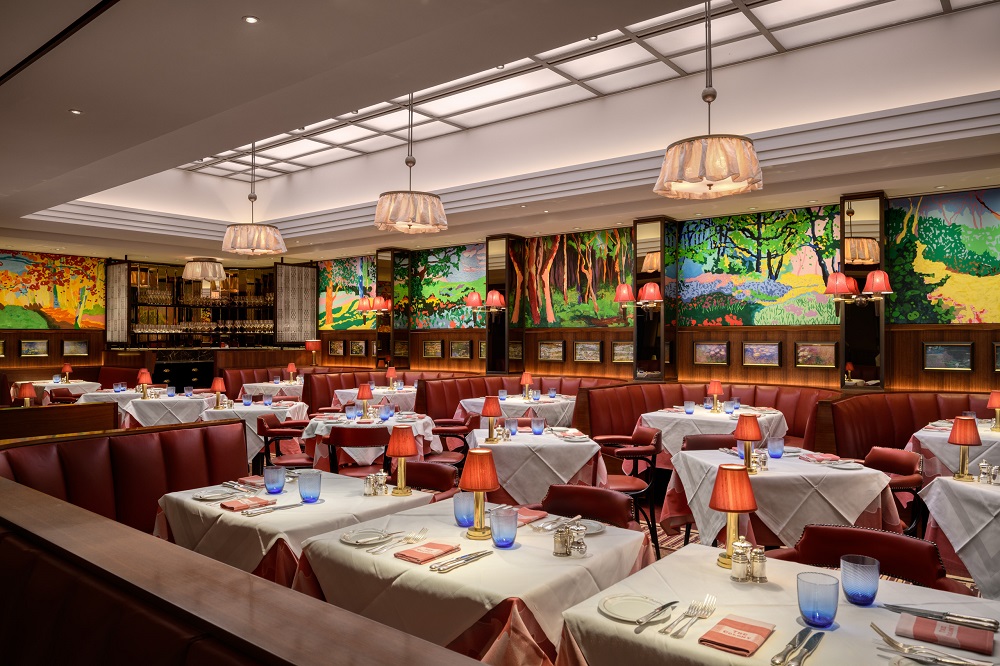
Image credit: The Beaumont / ZACandZAC
MB: Depending on who your client is, it can be a challenge. However, I would say that, emotionally (taking out commercial interests), clients want to design consciously. I have worked on a few projects now where the client has approached us with perhaps not an understanding but certainly clear aspirations of what they want to attain, which is certainly a refreshing shift.
I was surprised when quite a commercially driven client was adamant for us to achieve the best we could across the board in terms of energy usage and sustainability. It turns out, she had spent the last few years home-schooling her children, and they started to ask her what she was doing with the buildings she is creating to make them thoughtful. The challenge is that everyone has the desire to make these changes, it then comes down to justifying the commercial value, and this is where engineers come in, who can prove the return; spending more money in the construction can significantly increase the full life of the building.
David Mason: There was a lot of greenwashing, at first, from hotels. Everyone now, though, is becoming savvier and there’s a greater understanding across the industry on what that greenwashing looks like. Young consumers, a new generation of travellers, want to see the eco credentials of buildings and businesses, so it’s harder to make claims without backing it up with data.
MB: In the last year, I would say, there has been an evolution among authorities. When you put in for pre-application, there will be questions where there were not before. And that has been useful for our clients to think about things like water usage and energy from day one.

Image credit: Marylebone Lane Hotel / EPR Architects
Another part, I find useful is the investors and the funders who have their own obligations in terms of what they are doing as a business to be more ethical. There are so many other pressures that are putting sustainability high up on the agenda.
Veronica Givone: All of this is much easier when approaching a new-build hotel because there are more tools available on those projects, allowing investors to be more aware of the collaborative ways and solutions put forward by designers and architects.
The problem, in my opinion, is when you approach a heritage building and there is an awareness but there is also a large cost to implement such mechanical elements. This is when we often must reach a compromise, not necessarily respecting what all parties would like, in order to satisfy the commercial aspect of the project. In my opinion, the government should stand in to influence and help developers and investors to preserve existing structures.
HK: It’s interesting, because the perception is that renovating a heritage building is more sustainable than creating a hotel in a new-build property, but that is not always the case when, much of the time, the cost to be fully sustainable in such a project is not realistic. Would you say then that there’s more of a desire, among clients, to work on new-build structures, where engineering and mechanical elements can be easily added in the foundation of the project to reduce energy and water consumption?
VG: There are more surprises along the way when designing hotels in heritage buildings. Even a project that I have been working on since 2018, which is now on site. Last year, when demolishing started, they discovered new and unexpected challenges. These discoveries impact the design, architecture as well as all the processes including mechanical and operations.
DB: As a developer, yes, new builds are easier to manage. The redevelopment side of heritage sites is the unknown – you just don’t know what you’re going to run into, and that has an adverse effect on the design and what you can and can’t do, which leads to delays.
DM: New builds allow you to look at the lifecycle of the building, which is another way to really push the sustainability agenda. We clipped an office building into a hotel and came into various challenges there due to ceiling heights and changing how the building works. More and more, now we are looking at the flexibility of a space, to understand how it could be converted in years to come.
DB: We are about to start on a new project, Dolphin Square in Pimlico. For myself, the location is great – just off the River Thames. The aim of the project is the bring it back to what it was, and there’s something unmatched about doing that. Of course, we expect to run into challenges along the way, but the site’s heritage will become its strength.
MB: From an architect’s point of view, we have a healthy balance between new-builds and heritage buildings. I agree, you must approach each one very differently. You know pretty much everything that’s happening in a new build, whereas heritage sites can lead to adversity. However, what we find is that, commercially, there are pros and cons. For example, in hotel projects sheltered inside existing buildings, the programme becomes smoother because you are not knocking a building down and starting from scratch. Don’t get me wrong, everybody wants a new build to ensure their MEP systems work beautifully, but in a heritage building you’re sometimes able to open the hotel a bit sooner. What we find with projects in the heritage buildings is that you need to have a fantastic team, full of people who know what they are doing.

Image caption: The OWO Whitehall, designed by EPR Architects, which will contain the first Raffles hotel in the UK | Image credit: Grain London
Paul Scriven: The Whole Life Carbon approach is finally driving this. Local Authorities, especially in major cities, such as London are questioning all demolition and new-build projects on a life cycle basis. The embodied carbon, measuring emissions associated with materials and construction processes throughout the whole lifecycle of a building, approach is key to the success of our planet’s future.
VG: This comes back to collaboration and open communication, which makes working on these projects more enjoyable!
JS: And, I would say, getting rid of the blame culture, so that when something comes up, everyone is working on a solution together.
HK: What innovative solutions are being used to reduce energy consumption and carbon used when designing hotels?
JS: I think it is about designing buildings with circular potential. The biggest problem here is that many materials are not suitable for reuse as they were not designed for deconstruction. An approach we always take when designing a hotel is to try and retain as much of the existing building as possible.
Take the Beaumont for example, the façade is Grade II listed which meant we had to retain it, but on the new extension to the building, a project we are currently working with HDR on, the façade is not listed, so there was no requirement to keep it. Technically, it would have been much easier to demolish and re-build, but we made a conscious decision to preserve the façade, which is significantly better for the environment.
PS: Sustainability is at the heart of the design and operation. An integrated design complete with successful delivery via a dedicated Sustainability Champion has proven successful when we are delivering projects. In addition, there’s a heavy reliance on contractors to drive the sustainable agenda especially when considering value engineering.
DM: I’ve heard some calls for sustainable consultants to be part of projects, but we need to understand first how they are measuring this to accurately understand the true data behind the sustainability credentials.
MV: We have these conversations a lot, but our job is to take the discussion into implementation. Every project we work on, we end up providing a shopping list of engineer services we can offer, but you must have the client on board and understanding. Now, I would say that we are still talking a lot more than doing, but hotels are, generally speaking, behind the curve.
DM: Commercial offices have been doing this for quite a lot longer, perhaps because they are rentable spaces, but that sector is clearly setting a benchmark.
DB: Design certainly plays more of a role in hotel development; it’s key in such a wider range than simply aesthetic. The design of anything these days needs to be flexible to accommodate our changed behaviour as consumers.
“In our corner of the industry, looking at MEP, a vast array of technologies are being used and considered.” – Paul Scriven, Energy & Sustainability Director, HDR.
MB: Clients are becoming further informed [from sectors such as commercial offices] about sustainable alternatives, when specified and considered cleverly, don’t have to cost the earth. From a hotel side, the conversation I think we are ahead of the curve on is wastage. Hotels have historically generated a huge amount of waste. Even luxury hotels in central London are having conversations between all departments about how to significantly reduce waste, and the details they are going into is inspiring.
MV: It’s a governance situation as well. In the UK, we use BREAM which looks at how buildings are constructed, but we don’t tend to use LEED, which focuses more on operational cost as well as how the building operates. Those standards have started to creep in thanks to the ESG agenda, and that will hopefully start to determine factors early in the design process to reduce carbon footprints.
PS: In our corner of the industry, looking at MEP, a vast array of technologies are being used and considered. For example, low and zero carbon technologies; mass, form and building envelope optimisation, mixed ventilation, advanced LED lighting and controls, smart rooms, adaptable ventilation, reclaim of waste and innovative heat and cooling systems.
HK: The fact that everyone is talking about this is such a leap forward. The other thing that has inspired me recently, is hearing from experts such as yourselves that no one has all the answers, yet, and only through a collaborative approach can we find solutions.
MB: That is the exciting part. We are all having these conversations much more than we were before. The learning curve that we are all on, is understanding what happens to materials in the future, which has allowed us to make much more intuitive decisions, backed by research.
Main image credit: Unsplash/R Architecture




